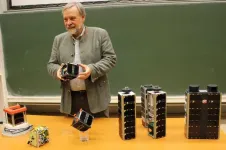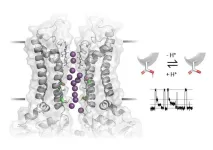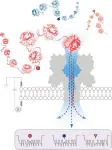(Press-News.org) Aug. 1, 2023
Contact: Derek Smith, 734-546-3632, smitdere@umich.edu
Katherine McAlpine, 734-647-7087, kmca@umich.edu
Images
Cracking in lithium-ion batteries speeds up electric vehicle charging
Cracks in predominant lithium-ion electrodes shorten battery lifespans, but a neuroscience-inspired technique shows that they have an upside
ANN ARBOR—Rather than being solely detrimental, cracks in the positive electrode of lithium-ion batteries reduce battery charge time, research done at the University of Michigan shows.
This runs counter to the view of many electric vehicle manufacturers, who try to minimize cracking because it decreases battery longevity.
"Many companies are interested in making 'million-mile' batteries using particles that do not crack. Unfortunately, if the cracks are removed, the battery particles won’t be able to charge quickly without the extra surface area from those cracks," said Yiyang Li, assistant professor of materials science and engineering and corresponding author of the study published in Energy and Environmental Sciences.
"On a road trip, we don't want to wait five hours for a car to charge. We want to charge within 15 or 30 minutes."
The team believes the findings apply to more than half of all electric vehicle batteries, in which the positive electrode—or cathode—is composed of trillions of microscopic particles made of either lithium nickel manganese cobalt oxide or lithium nickel cobalt aluminum oxide. Theoretically, the speed at which the cathode charges comes down to the particles' surface-to-volume ratio. Smaller particles should charge faster than larger particles because they have a higher surface area relative to volume, so the lithium ions have shorter distances to diffuse through them.
However, conventional methods couldn't directly measure the charging properties of individual cathode particles, only the average for all the particles that make up the battery's cathode. That limitation means the widely accepted relationship between charging speed and cathode particle size was merely an assumption.
"We find that the cathode particles are cracked and have more active surfaces to take in lithium ions—not just on their outer surface, but inside the particle cracks," said Jinhong Min, a doctoral student in materials science and engineering working in Li's lab. "Battery scientists know that the cracking occurs but have not measured how such cracking affects the charging speed."
Measuring the charging speed of individual cathode particles was key to discovering the upside to cracking cathodes, which Li and Min accomplished by inserting the particles into a device that is typically used by neuroscientists to study how individual brain cells transmit electrical signals.
"Back when I was in graduate school, a colleague studying neuroscience showed me these arrays that they used to study individual neurons. I wondered if we can also use them to study battery particles, which are similar in size to neurons," Li said.
Each array is a custom-designed, 2-by-2 centimeter chip with up to 100 microelectrodes. After scattering some cathode particles in the center of the chip, Min moved single particles onto their own electrodes on the array using a needle around 70 times thinner than a human hair. Once the particles were in place, Min could simultaneously charge and discharge up to four individual particles at a time on the array and measured 21 particles in this particular study.
The experiment revealed that the cathode particles' charging speeds did not depend on their size. Li and Min think that the most likely explanation for this unexpected behavior is that larger particles actually behave like a collection of smaller particles when they crack. Another possibility is that the lithium ions move very quickly in the grain boundaries—the tiny spaces between the nanoscale crystals comprising the cathode particle. Li thinks this is unlikely unless the battery's electrolyte—the liquid medium in which the lithium ions move—penetrates these boundaries, forming cracks.
The benefits of cracked materials are important to consider when designing long-lived batteries with single-crystal particles that don't crack. To charge quickly, these particles may need to be smaller than today's cracking cathode particles. The alternative is to make single-crystal cathodes with different materials that can move lithium faster, but those materials could be limited by the supply of necessary metals or have lower energy densities, Li said.
The device was built in the Lurie Nanofabrication Facility and studied at the Michigan Center for Materials Characterization.
The research was funded by LG Energy Solution, Battery Innovation Contest and the University of Michigan College of Engineering.
Study: Direct measurements of size-independent lithium diffusion and reaction times in individual polycrystalline battery particles (DOI: 10.1039/D3EE00953J)
END
Cracking in lithium-ion batteries speeds up electric vehicle charging
Cracks in predominant lithium-ion electrodes shorten battery lifespans, but a neuroscience-inspired technique shows that they have an upside
2023-08-01
ELSE PRESS RELEASES FROM THIS DATE:
Tracking periodontal disease to improve diagnosis and treatment
2023-08-01
INDIANAPOLIS – Periodontal disease is a growing public health issue in the United States as the nation’s population ages, yet it’s underdiagnosed and undertreated. According to the U.S. Centers for Disease Control and Prevention (CDC), 47 percent of adults aged 30 years and older and 79 percent of adults 65 years and older have some form of periodontal disease.
Researchers from Regenstrief Institute and Indiana University School of Dentistry have developed computer algorithms to track periodontal disease change, which could help dentists and periodontists follow disease progression. They also have developed tools to ...
Frank J. Malina Astronautics Medal awarded to Klaus Schilling
2023-08-01
The International Astronautical Federation (IAF) selected Würzburg space expert Professor Klaus Schilling for the Frank J. Malina Astronautics Medal 2023. This medal is a top award in the space sector for innovative research and for commitment to education.
According to a statement by the IAF, the medal is awarded each year to a personality who has provided outstanding services to space education and research. This applies to Professor Schilling without reservation: "He has provided numerous students with practical experience in satellite construction and has been involved in a wide ...
New study sheds light on the gating mechanism of ion channels
2023-08-01
Ion channels play a crucial role in many cellular processes, including neuronal communication, muscle contraction or cell proliferation. Most multi subunit ion channels exist in two functional states, either closed or open. During gating, one should expect that all subunits undergo conformational changes. The absence of intermediate conduction levels is surprising and asks for an explanation. A team of researchers from the University of Vienna and the Washington University in St. Louis created a smart model system to answer this important question. The study is currently published in Nature ...
Fossil unveils leaf eating among earliest birds
2023-08-01
A new type of analysis of a spectacular 120-million-year-old fossil skeleton of the extinct early bird Jeholornis from northeastern China has revealed the oldest evidence for birds eating leaves, marking the earliest known evolution of arboreal plant-eating among birds.
The pheasant-sized Jeholornis, a member of the second most primitive lineage of known birds, has teeth and a long bony tail like its predatory, feathered dinosaur relatives. However, microscopic analysis of the fossilized residues in the stomach of this juvenile, arboreal (tree-living) bird demonstrates that Jeholornis was not a predator. It had eaten tree leaves from a group ...
Nanopore technology achieves breakthrough in protein variant detection
2023-08-01
Scientists have developed a breakthrough method to detect structural variations on proteins based on nanopore technologies.
Protein chains are fed through an engineered nanopore, with subtle variations in structure detected through the modulation of tiny electrical currents.
The method could transform our understanding of how protein variants are associated with diseases, and allow point-of-care diagnostics.
A team of scientists led by the University of Oxford have achieved a significant breakthrough in detecting modifications on protein structures. The method, published in Nature Nanotechnology, employs innovative nanopore technology to identify structural ...
Google & ChatGPT have mixed results in medical informatiom queries
2023-08-01
When you need accurate information about a serious illness, should you go to Google or ChatGPT?
An interdisciplinary study led by University of California, Riverside, computer scientists found that both internet information gathering services have strengths and weaknesses for people seeking information about Alzheimer's disease and other forms of dementia. The team included clinical scientists from the University of Alabama and Florida International University.
Google provides the most current information, but query results are skewed by service and product providers seeking customers, the researchers found. ChatGPT, meanwhile, ...
A novel laser slicing technique for diamond semiconductors
2023-08-01
Silicon-based materials are currently the undisputed leaders in the field of semiconductors. Even so, scientists around the world are actively trying to find superior alternatives for next-generation electronics and high-power systems. Interestingly, diamonds are among the most promising materials for applications such as fast telecommunications and power conversion in electric vehicles and power plants.
Despite their attractive properties for the semiconductor industry, the applications of diamonds are limited due to the lack of techniques to slice them into thin wafers efficiently. As a result, diamond wafers must be synthesized one by one, making fabrication ...
California’s winter waves may be increasing under climate change
2023-08-01
A new study from UC San Diego Scripps Institution of Oceanography researcher emeritus Peter Bromirski uses nearly a century of data to show that the average heights of winter waves along the California coast have increased as climate change has heated up the planet.
The study, published today in the Journal of Geophysical Research - Oceans, achieved its extraordinarily long time series by using seismic records dating back to 1931 to infer wave height, a unique but accepted method first developed by Bromirski in 1999. The results, made more robust by their ...
DNA decodes the dining preferences of the shell-shucking whitespotted eagle ray
2023-08-01
With mighty jaws and plate-like teeth, the whitespotted eagle ray (Aetobatus narinari) can pretty much crunch on anything. In fact, hard clam farmers in Florida’s Indian River Lagoon have considered this species a threat to their production efforts and profit margin. This assumption, however, is mostly anecdotal.
Despite their protected status in Florida and designation as globally “endangered,” there is limited information in the United States available on critical components of the life history of the whitespotted eagle ray, such as their diet. Prior observations have described a location-specific yet variable diet consisting of hard ...
GI symptoms persist in older female colorectal cancer survivors
2023-08-01
COLUMBUS, Ohio – More than 4 out of 5 older women survivors of colorectal cancer may be experiencing a range of gastrointestinal symptoms many years after being diagnosed and treated, a new study suggests.
Using data from the Women’s Health Initiative, researchers found that 81% of colorectal cancer survivors reported persistent GI symptoms, with abdominal bloating and gas topping the list as the most common and severe problem. The average time since diagnosis was eight years for all participants whose data was used in the study.
The analysis also showed that severe GI symptoms were linked to poor quality of life, ...
LAST 30 PRESS RELEASES:
Severe weather is deadly for vulnerable older adults long after the storm ends, study finds
Expert panel highlights opportunities for improving cancer studies
Hearing aid prescriptions not associated with changes in memory and thinking
Seth Zippel selected for The Oceanography Society Early Career Award
Jeremy Horowitz selected for The Oceanography Society Early Career Award
Kennesaw State University’s Jerry Mack named Paul “Bear” Bryant Newcomer Coach of the Year
Ancient teeth are treasure troves of data on Iron Age lifestyles
Avocados may become easier to grow in India—but not if global emissions remain high
Pregnant women with IBD show heightened inflammation in vaginal mucosa
Underwater photos show seabirds, seals and fish interacting with a tidal turbine in Washington State
1 in 5 surveyed UK adults who have experienced the death of a pet report it as more distressing than experienced human deaths, with significant rates of prolonged grief disorder symptoms also being re
Polyester microfibers in soil negatively impact the development of cherry tomato plants in experiments, raising concerns over the potential effect of high levels of such contaminants
LGBTQ+ adults may be around twice as likely to be unemployed or to report workforce non-participation compared to heterosexual adults, per large representative Australian survey
Horses can smell fear: In experiments where horses smelled sweat from scared humans, they reacted to scary and sudden events with increased fear and reduced human interaction
New synaptic formation in adolescence challenges conventional views of brain development
Scientists identify target to treat devastating brain disease
Oliver Zielinski selected as Fellow of The Oceanography Society
Has progress stalled on gender equality at work?
Quantum simulator sheds light on how nature moves energy in systems like photosynthesis and solar conversion
Can a hashtag help prevent atrocities? Study shows social media can be a powerful tool
The American Ornithological Society (AOS) announces the winner of the 2025 Wesley Lanyon Award
Woolly rhino genome recovered from Ice Age wolf stomach
An earthquake on a chip: New tech could make smartphones smaller, faster
New research shows how AI tools are expanding individual capabilities while contracting scientific attention
A nanomaterial flex — MXene electrodes help OLED display technology shine, while bending and stretching
Global research team uncovers mechanism by which metabolites guide cellular decisions
Work hours, stress, and burnout among resident physicians
Quality of life of parents of premature infants
Should younger and older people receive different treatments for the same infection?
Scientists discover how fast the world’s deltas are sinking
[Press-News.org] Cracking in lithium-ion batteries speeds up electric vehicle chargingCracks in predominant lithium-ion electrodes shorten battery lifespans, but a neuroscience-inspired technique shows that they have an upside





